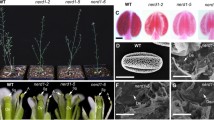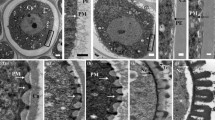Abstract
In the male sterile32(ms32)mutant in Arabidopsis thaliana, pollen development is affected during meiosis of pollen mother cells (PMCs). In normal wild-type (WT) anthers, callose is deposited around PMCs before and during meiosis, and after meiosis the tetrads have a complete callose wall. In ms32, PMCs showed initial signs of some callose deposition before meiosis, but it was degraded soon after, as was part of the cellulosic wall around the PMCs. The early dissolution of callose in ms32 was associated with the occurrence of extensive stacks of rough ER (RER) in tapetal cells. The stacks of RER were also observed in the WT tapetum, but at a later stage, i.e., after the tetrads were formed and when callose is normally broken down for release of microspores. Based on these observations it is suggested that: (1) callose degradation around developing microspores is linked to the formation of RER in tapetal cells, which presumably synthesize and/or secrete callase into the anther locule, and (2) mutation in MS32 disrupts the timing of these events.
Similar content being viewed by others
Author information
Authors and Affiliations
Additional information
Received: 27 April 1999 / Revision accepted: 21 June 1999
Rights and permissions
About this article
Cite this article
Fei, H., Sawhney, V. MS32-regulated timing of callose degradation during microsporogenesisin Arabidopsis is associated with the accumulation of stacked rough ER in tapetal cells. Sex Plant Reprod 12, 188–193 (1999). https://doi.org/10.1007/s004970050191
Issue Date:
DOI: https://doi.org/10.1007/s004970050191




